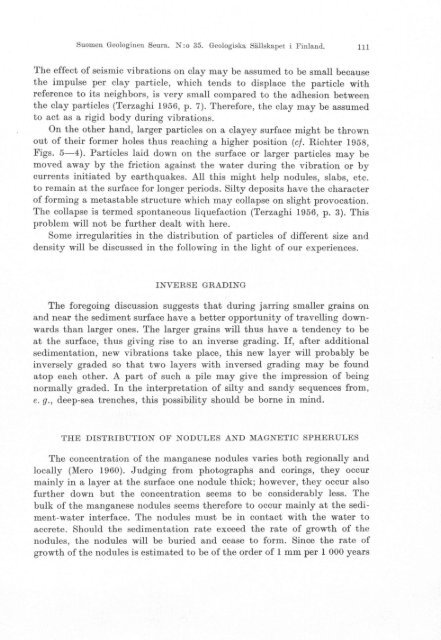COMMISSION GEOLOGIOUE - Arkisto.gsf.fi
COMMISSION GEOLOGIOUE - Arkisto.gsf.fi
COMMISSION GEOLOGIOUE - Arkisto.gsf.fi
Create successful ePaper yourself
Turn your PDF publications into a flip-book with our unique Google optimized e-Paper software.
Suomen Geologinen Seura. N: 0 35. Geologiska Sällskapet i Finland. 111<br />
The effect of seismic vibrations on clay may be assumed to be small because<br />
the impulse per clay particle, which tends to displace the particle with<br />
reference to its neighbors, is very small compared to the adhesion between<br />
the clay particles (Terzaghi 1956, p. 7). Therefore, the clay may be assumed<br />
to act as a rigid body during vibrations.<br />
On the other hand, larger particles on a clayey surface might be thrown<br />
out of their former holes thus reaching a higher position (cf. Richter 1958,<br />
Figs. 5-4). Particles laid down on the surface or larger particles may be<br />
moved away by the friction against the water during the vibration or by<br />
currents initiated by earthquakes. All this might help nodules, slabs, etc.<br />
to remain at the surface for longer periods. Silty deposits have the character<br />
of forming a metastable structure which may collapse on slight provocation.<br />
The collapse is termed spontaneous liquefaction (Terzaghi 1956, p. 3). This<br />
problem will not be further dealt with here.<br />
Some irregularities in the distribution of particles of different size and<br />
density will be discussed in the following in the light of our experiences.<br />
INVERSE GRADING<br />
The foregoing discussion suggests that during jarring smaller grains on<br />
and near the sediment surface have a better opportunity of travelling downwards<br />
than larger ones. The larger grains will thus have a tendency to be<br />
at the surface, thus giving rise to an inverse grading. If, after additional<br />
sedimentation, new vibrations take place, this new layer will probably be<br />
inversely graded so that two layers with inversed grading may be found<br />
atop each other. Apart of such a pile may give the impression of being<br />
normally graded. In the interpretation of silty and sandy sequences from,<br />
e. g., deep-sea trenches, this possibility should be borne in mind.<br />
THE DISTRIBUTION OF NODULES AND MAGNETIC SPHERULES<br />
The concentration of the manganese nodules varies both regionally and<br />
locally (Mero 1960). Judging from photographs and corings, they occur<br />
mainly in a layer at the surface one nodule thick; however, they occur also<br />
further down but the concentration seems to be considerably less. The<br />
bulk of the manganese nodules seems therefore to occur mainly at the sediment-water<br />
interface. The nodules must be in contact with the water to<br />
accrete. Should the sedimentation rate exceed the rate of growth of the<br />
nodules, the nodules will be buried and cease to form. Since the rate of<br />
growth of the nodules is estimated to be of the order of 1 mm per 1 000 years
















